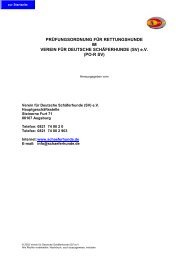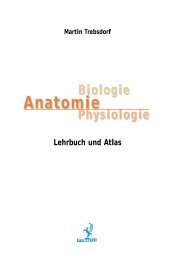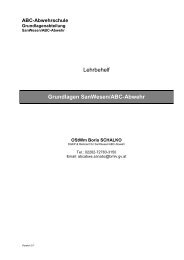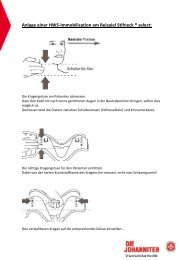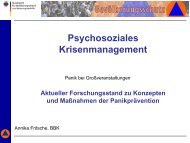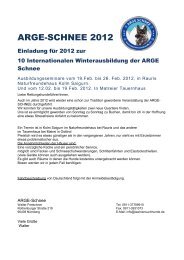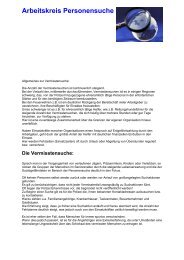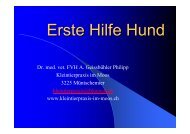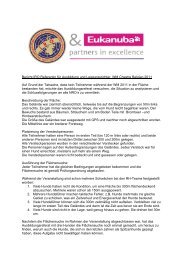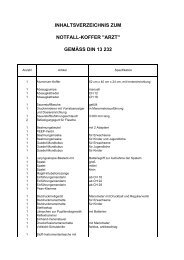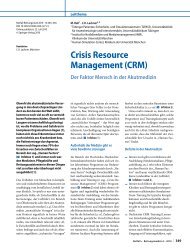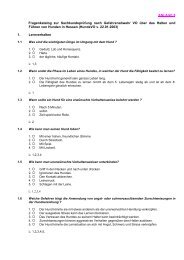guidelines to training a disaster search & rescue dog - Sardog
guidelines to training a disaster search & rescue dog - Sardog
guidelines to training a disaster search & rescue dog - Sardog
Create successful ePaper yourself
Turn your PDF publications into a flip-book with our unique Google optimized e-Paper software.
GUIDELINES TO TRAINING A URBAN SEARCH &<br />
RESCUE DOG<br />
There are may different, tried and tested ways of <strong>training</strong> <strong>search</strong> and <strong>rescue</strong> <strong>dog</strong>s throughout the world.<br />
The stages laid down in this document are some of the <strong>training</strong> <strong>guidelines</strong> adopted by the<br />
UKFSSART Dog Teams.<br />
INTRODUCTION<br />
All <strong>dog</strong>s should be fully proficient at every stage of <strong>training</strong> before being moving on<strong>to</strong> the next stage of<br />
<strong>training</strong>. This should be checked by a competent instruc<strong>to</strong>r / handler. Each individual <strong>dog</strong> is like a<br />
human that has different levels of learning ability, some will learn faster then others. Never rush your<br />
<strong>dog</strong> through any stage of the <strong>dog</strong>s <strong>training</strong>, <strong>to</strong> do so will only cause complications further in the <strong>dog</strong>s<br />
<strong>training</strong>, that always inevitably means backtracking on the stages of <strong>training</strong>. The only person that can<br />
be held responsible if you get <strong>to</strong> this stage is yourself and not your <strong>dog</strong>, you have been warned !!!.<br />
Relationship<br />
A bond must be formed between <strong>dog</strong> and handler from day one, the relationship will start <strong>to</strong> develop<br />
through feeding, grooming, walking and spending as much time as possible with your new <strong>dog</strong>. At all<br />
times the puppy must understand the natural pecking order with its handler, <strong>to</strong> archive this the <strong>dog</strong><br />
must be handled in a controlled, but fair disciplined manner <strong>to</strong> allow the <strong>dog</strong> <strong>to</strong> understand that its<br />
handler is its master. Through this type of relationship, trust, respect and understanding will be formed<br />
between <strong>dog</strong> and handler.<br />
Agility <strong>training</strong><br />
Created by C.Pritchard © for United Kingdom Fire Service Urban Search & Rescue Dog Teams
This taught <strong>to</strong> the <strong>dog</strong> and handler <strong>to</strong> be able:<br />
• To negotiate any natural or man-made object that it may encounter in the course of an<br />
operational <strong>search</strong>.<br />
• To improve the <strong>dog</strong>s confidence and build on <strong>dog</strong> & handler relationship.<br />
Considerations <strong>to</strong> be taken in<strong>to</strong> account when carrying out an agility session: -<br />
Age of the <strong>dog</strong>.<br />
The <strong>dog</strong>’s ability & stage of <strong>training</strong>.<br />
Fitness of the <strong>dog</strong>.<br />
Safe construction and stability of the obstacles and the general area for hazards.<br />
To assist the <strong>dog</strong> in negotiating an obstacle the following words of command can be used:<br />
Agility courses e.g. especially where the <strong>dog</strong> has <strong>to</strong> jump through an obstacle and land several feet<br />
below should not be used until the <strong>dog</strong> is at least 12 months old as the <strong>dog</strong> is still developing (growing)<br />
until then.<br />
Natural agility <strong>training</strong><br />
This is designed <strong>to</strong> be a change from normal agility <strong>training</strong>.<br />
The <strong>training</strong> should be pre-planned <strong>to</strong> include as much variation as possible.<br />
Natural obstacles and the environment should be used that the <strong>dog</strong> will encounter on a typical<br />
<strong>search</strong> in the course of the <strong>dog</strong>s <strong>training</strong>.<br />
The most important rule is always cater for the least agile / youngest canine member in the team <strong>to</strong><br />
assist in building up there confidence.<br />
Obedience<br />
Is the most important fac<strong>to</strong>r <strong>to</strong> a well-trained and obedient <strong>dog</strong>. It is through short and frequent lessons<br />
that the <strong>dog</strong> becomes conditioned <strong>to</strong> its handlers voice and responds <strong>to</strong> the basic words of command<br />
that are taught Through repetition, patience and time. The <strong>dog</strong> will conform <strong>to</strong> all commands that are<br />
taught <strong>to</strong> them, remembering <strong>to</strong> always praise the <strong>dog</strong> when they carry out a task correctly. This allows<br />
the <strong>dog</strong> <strong>to</strong> learn right from wrong.<br />
Obedience <strong>training</strong><br />
• Training periods should vary <strong>to</strong> suit the temperament and maturity of <strong>dog</strong>.<br />
• Carried out 3 – 4 times a day for approximately 5 – 10 minutes each session.<br />
• Each <strong>dog</strong> will have its own rate of progress.<br />
• All <strong>training</strong> <strong>to</strong> be given in short sessions.<br />
• Made <strong>to</strong> be interesting and fun if not, the <strong>dog</strong> will become stale, disinterested & unwilling.<br />
Methods of reward<br />
Created by C.Pritchard © for United Kingdom Fire Service Urban Search & Rescue Dog Teams
• Verbal praise<br />
• Physical Praise patting / stroking<br />
• Playing with the <strong>dog</strong><br />
• Retrieving with a <strong>to</strong>y<br />
Correcting a <strong>dog</strong><br />
The voice can be used in different ways <strong>to</strong> get the <strong>dog</strong> <strong>to</strong> respond<br />
• Loud or quiet<br />
• High or low pitched<br />
• Sharp or drawn out<br />
• Find what <strong>to</strong>ne of voice produces the best results<br />
When the handler gives reward or correction, this must be given without delay so that the <strong>dog</strong><br />
associates right from wrong.<br />
The timing of the commands must be given before the action is carried out. This will allow the <strong>dog</strong><br />
time <strong>to</strong> think and react <strong>to</strong> the command that has been given, before the handler carries out the<br />
movement.<br />
There are also other alternative methods that can be adopted like clicker <strong>training</strong> that get the same<br />
desired facts.<br />
Basic words of command and positions<br />
Sit<br />
Heel Moving Position<br />
Created by C.Pritchard © for United Kingdom Fire Service Urban Search & Rescue Dog Teams
Heel: Dog <strong>to</strong> sit next or be close <strong>to</strong> the left hand side of the handler’s body.<br />
Present / Sit Heel Sit<br />
Down Stay Come<br />
Stay: Used <strong>to</strong> command the <strong>dog</strong> <strong>to</strong> stay in a position e.g. sit, down or used immediately <strong>to</strong> get the <strong>dog</strong><br />
<strong>to</strong> stand his ground.<br />
Come: To inform the <strong>dog</strong> <strong>to</strong> return <strong>to</strong> its handler immediately.<br />
Leave: To the <strong>dog</strong> <strong>to</strong> s<strong>to</strong>p immediately the action that it is carrying out.<br />
E.G. drop from its mouth any foreign object that it may of picked up off the ground.<br />
Working word of command<br />
Find: This word of command is taught <strong>to</strong> the <strong>dog</strong> <strong>to</strong> associate with work, (play) this command is<br />
introduced once the <strong>dog</strong> starts <strong>to</strong> retrieve.<br />
Additional words of command<br />
Speak: This word of command is initially taught <strong>to</strong> the <strong>dog</strong> <strong>to</strong> teach him <strong>to</strong> bark. It is used <strong>to</strong> enhance<br />
the <strong>dog</strong>s indicate <strong>to</strong> assist in the developing of the <strong>dog</strong>s indication <strong>to</strong> show that the <strong>dog</strong> has found a<br />
person.<br />
Created by C.Pritchard © for United Kingdom Fire Service Urban Search & Rescue Dog Teams
No: This word of command is used <strong>to</strong> prevent the <strong>dog</strong> from carrying out any undesirable act that the<br />
handler does not want the <strong>dog</strong> <strong>to</strong> do.<br />
To assist the <strong>dog</strong> in negotiating an obstacle the following words of command can be used:<br />
Over:<br />
To jump over an object.<br />
Up:<br />
Used <strong>to</strong> command the <strong>dog</strong> <strong>to</strong> jump on<strong>to</strong> an object.<br />
Through: To command the <strong>dog</strong> through small openings / obstacles.<br />
Created by C.Pritchard © for United Kingdom Fire Service Urban Search & Rescue Dog Teams
S<strong>to</strong>ck testing<br />
Lives<strong>to</strong>ck / wildlife testing must be carried out at an early stage of the <strong>dog</strong>s life. The <strong>dog</strong> must be at all<br />
times trustworthy around any forms of lives<strong>to</strong>ck. This also includes <strong>training</strong> the <strong>dog</strong> <strong>to</strong> ignore and<br />
work around any form of wildlife that the <strong>dog</strong> may encounter at any time:<br />
• Rabbits<br />
• Waterfowl<br />
• Foxes<br />
• Pheasants<br />
• Etc<br />
This form of <strong>training</strong> must be regularly carried out throughout the <strong>dog</strong>s working life.<br />
STAGE ONE OF SEARCH WORK<br />
Environmental Training must be introduced from an early age. This Stage is extremely<br />
important in the development of the <strong>dog</strong> and should be carried out on a regular basis day and night.<br />
The <strong>dog</strong>s must be conditioned <strong>to</strong> the noise and disruption associated with <strong>rescue</strong> operations such as<br />
heavy plant, genera<strong>to</strong>rs and disturbance that would be generated from a collapsed structure<br />
environment with all associated articles that would be found in a dwelling/building. They are taught <strong>to</strong><br />
ignore attractive scents such as food and other animals <strong>to</strong> assure a negative response whilst <strong>search</strong>ing<br />
for live bodies. The <strong>dog</strong>s are taught through environmental <strong>training</strong> <strong>to</strong> be able <strong>to</strong> negotiate any<br />
reasonable obstacle that they may encounter whilst carrying out a <strong>search</strong>.<br />
Once the <strong>dog</strong> becomes accus<strong>to</strong>med and proficient it will be able <strong>to</strong> work in or around any situation that<br />
it may encounter, without being distracted or stressed in any way.<br />
Retrieving is the key <strong>to</strong> <strong>search</strong> & <strong>rescue</strong> work, this is the reward and fun that drives the <strong>dog</strong> <strong>to</strong> <strong>search</strong><br />
an area. Retrieving is the foundations in developing an excellent <strong>search</strong> & <strong>rescue</strong> <strong>dog</strong> and must be<br />
used regularly throughout the stages of <strong>training</strong> and carried out daily throughout the <strong>dog</strong>s career.<br />
Created by C.Pritchard © for United Kingdom Fire Service Urban Search & Rescue Dog Teams
The <strong>to</strong>y (example squeaky ball) is thrown out and the working word of command “find” is given <strong>to</strong> the<br />
<strong>dog</strong>. The <strong>dog</strong> is encouraged <strong>to</strong> retrieve the <strong>to</strong>y and return <strong>to</strong> its handler, where praise is given. This<br />
stage is continued in all types of terrain and environments until the <strong>dog</strong> is proficient at finding the <strong>to</strong>y.<br />
The <strong>dog</strong> is also encouraged from its handler <strong>to</strong> bark (speak) for the <strong>to</strong>y every time it is squeaked or<br />
played with. This process is the first stage in teaching the <strong>dog</strong> <strong>to</strong> indicate.<br />
To enhance the <strong>dog</strong>’s drive and enthusiasm on this stage of <strong>training</strong> the handler or an assistant can hold<br />
back the <strong>dog</strong> by either the lead or working harness, before the <strong>to</strong>y is thrown out in<strong>to</strong> the <strong>search</strong> area out<br />
of sight.<br />
Example behind a pile of rubble, dense undergrowth.<br />
The <strong>dog</strong> is held back for approx. 5 <strong>to</strong> 10 seconds before released, the working word of command find<br />
is also given. The time delay can be increased gradually until the <strong>dog</strong> is locating the <strong>to</strong>y after<br />
approximately 45 seconds. This is the first stage in teaching the <strong>dog</strong> <strong>to</strong> <strong>search</strong> using his nose <strong>to</strong> locate<br />
the <strong>to</strong>y instead of their eyes.<br />
Indication <strong>training</strong><br />
This is taught <strong>to</strong> the <strong>dog</strong> at every opportunity <strong>to</strong> train the <strong>dog</strong> <strong>to</strong> indicate <strong>to</strong> its handler that it has found<br />
a casualty by the <strong>dog</strong> barking (speaking). Once the <strong>dog</strong> has become proficient at indication <strong>training</strong> it<br />
should be regularly revisited.<br />
There are many tried and tested ways of carrying out this type of <strong>training</strong> some of these can be via play<br />
and food reward initially.<br />
Example of indication <strong>training</strong> getting the <strong>dog</strong> <strong>to</strong> bark for the <strong>to</strong>y whilst retrieving.<br />
The <strong>dog</strong> should be fully proficient at this stage with real drive and enthusiasm regarding <strong>search</strong>ing,<br />
retrieving and barking for the <strong>to</strong>y before moving on<strong>to</strong> a run away (stage two).<br />
STAGE TWO<br />
Run away<br />
The <strong>dog</strong> wearing its working harness is handled by its handler and an assistant (casualty) is used <strong>to</strong><br />
tease & excite the <strong>dog</strong> with a <strong>to</strong>y, before running out in<strong>to</strong> the area. The assistant continues <strong>to</strong> tease and<br />
Created by C.Pritchard © for United Kingdom Fire Service Urban Search & Rescue Dog Teams
call <strong>to</strong> the <strong>dog</strong> whilst finding a place <strong>to</strong> hide. Once the assistant is in a place of hiding (E.G.: lying<br />
down in a conceal position on the ground) the <strong>dog</strong> is released and the working command is given find.<br />
The handler gives verbal encouragement until the <strong>dog</strong> locates the assistant. When the <strong>dog</strong> has found<br />
the assistant the handler keeps quite at this stage so the <strong>dog</strong>’s attention is focused on the assistant with<br />
the <strong>to</strong>y.<br />
The assistant encourages the <strong>dog</strong> <strong>to</strong> bark (indicate) by using the <strong>to</strong>y as a reward. This exercise can also<br />
be carried out by an assistant moving in a zig - zag pattern across the <strong>search</strong> area, this is used <strong>to</strong> assist<br />
in preventing the <strong>dog</strong> from tracking the assistant in<strong>to</strong> the hiding place by means of the ground<br />
disturbance that has been caused by the assistants movements.<br />
STAGE THREE<br />
Run away with hides Following the same procedure as above, but this time the area has several<br />
box hides within the <strong>search</strong> area for the assistant <strong>to</strong> be completely concealed away from the <strong>dog</strong>s sight.<br />
When the <strong>dog</strong> has found the assistant the handler keeps quite so the <strong>dog</strong> can focus all their attention on<br />
the assistant with the <strong>to</strong>y. The assistant encourages the <strong>dog</strong> <strong>to</strong> bark (indicate) if required by using the<br />
<strong>to</strong>y as a reward. Once the <strong>dog</strong> has indicated the presents of the assistant, they then reveal themselves<br />
from the hide <strong>to</strong> play and fuss with the <strong>dog</strong>. The handler can then join in with this encouragement.<br />
The distance/area that the <strong>dog</strong> has <strong>to</strong> <strong>search</strong> is increased gradually and the amount of time that the<br />
assistant is in hiding is also increased before the <strong>dog</strong> is released <strong>to</strong> <strong>search</strong>. As the <strong>dog</strong> becomes more<br />
proficient the complexity of these hides are gradually increased in difficulty, as illustrated below.<br />
Created by C.Pritchard © for United Kingdom Fire Service Urban Search & Rescue Dog Teams
STAGE FOUR<br />
Delayed run away The <strong>dog</strong> is teased up by the assistant with the <strong>to</strong>y before running off in<strong>to</strong> the<br />
<strong>search</strong> area, at the same time the assistant is continually calling out <strong>to</strong> the <strong>dog</strong> before going in<strong>to</strong> hiding.<br />
The <strong>dog</strong> is then taken away from the <strong>search</strong> area for a period of time, before being brought back <strong>to</strong><br />
commence the <strong>search</strong>. The handler at this stage is continually giving the <strong>dog</strong> verbal / physical<br />
encouragement <strong>to</strong> keep the <strong>dog</strong> focused on finding the assistant.<br />
As the <strong>dog</strong> becomes proficient the time is gradually increased before the <strong>dog</strong> is brought back in<strong>to</strong> the<br />
<strong>search</strong> area. In time the delayed run away can be dispensed with, allowing the handler <strong>to</strong> bring the <strong>dog</strong><br />
<strong>to</strong> the <strong>search</strong> area without any input from the assistant. The handler will use verbal encouragement <strong>to</strong><br />
get the <strong>dog</strong> <strong>to</strong> carry out the <strong>search</strong> of the area.<br />
STAGE FIVE<br />
Consolidation <strong>training</strong> the assistant hides at different locations, left, right, centre of the <strong>search</strong><br />
area and uses varying heights <strong>to</strong> a max of 1 metre and depths of 12 inches. These heights and depths<br />
are increased as the <strong>dog</strong> becomes more proficient at finding and indicating the assistant/s. Maximum<br />
use of box hides or other natural hides or objects should be used <strong>to</strong> conceal the assistant’s. E.G.: under<br />
floorboards, inside cavity walls, cupboards, under shallow rubble.<br />
This stage is continued until the <strong>dog</strong> is proficient in finding the assistant after 15 minutes of <strong>search</strong>ing<br />
with a good indication.<br />
Once the <strong>dog</strong> has become proficient at this stage the assistant periodically s<strong>to</strong>ps taking the <strong>to</strong>y in<strong>to</strong><br />
hiding with them. This is used <strong>to</strong> reinforce that the <strong>dog</strong> is finding the assistant by using the human<br />
scent picture and not by the scent of the <strong>to</strong>y. Once the <strong>dog</strong> has indicated the presents of the assistant,<br />
the handler will remove the <strong>to</strong>y from their person, making sure that the <strong>dog</strong> doesn’t see it and then<br />
pretend <strong>to</strong> remove it from the hide where the assistant is hiding.<br />
Created by C.Pritchard © for United Kingdom Fire Service Urban Search & Rescue Dog Teams
There are two other forms of <strong>to</strong>y delivery that can be used:<br />
• The <strong>to</strong>y reward can be delivered by the handler, by throwing the <strong>to</strong>y in<strong>to</strong> the immediate area where<br />
the assistant is in hiding. The handler must make sure that the <strong>dog</strong> does not see the <strong>to</strong>y being thrown<br />
by them self. This type of reward must be precision ally timed <strong>to</strong> get maximum reward in believing<br />
that the <strong>to</strong>y has come from the assistant.<br />
• The handler moves in close <strong>to</strong> the assistants hiding place and removes the <strong>to</strong>y from their person and<br />
gives it <strong>to</strong> the assistant who then delivers it <strong>to</strong> the <strong>dog</strong>. An alternative <strong>to</strong> this is that the handler pretends<br />
<strong>to</strong> remove it from the hide location and delivers it himself directly <strong>to</strong> the <strong>dog</strong>.<br />
STAGE SIX<br />
Free / systematic <strong>search</strong> control<br />
To <strong>search</strong> an area effectively the area must be broken down by the handler in<strong>to</strong> manageable <strong>search</strong><br />
areas and the following <strong>search</strong> procedure must be followed: -<br />
This procedure is broken down in<strong>to</strong> two <strong>search</strong> sequences.<br />
1) Free <strong>search</strong>.<br />
2) Systematic <strong>search</strong><br />
3) Perimeter <strong>search</strong><br />
Free <strong>search</strong>: The handler allows the <strong>dog</strong> <strong>to</strong> <strong>search</strong> the area using its own initiative, with guidance<br />
from the handler if required.<br />
Systematic <strong>search</strong>: is then carried out by the handler who takes control of the <strong>search</strong> and directs the<br />
<strong>dog</strong> systematically throughout the area.<br />
Perimeter / boundary Search: must always be carried out on a building <strong>search</strong>, remembering <strong>to</strong><br />
<strong>search</strong> any cellars, attics, garages and outbuildings that have been incorporated in<strong>to</strong> the <strong>search</strong> area.<br />
Open areas must also have their boundaries <strong>search</strong>ed making sure that the handler has <strong>search</strong>ed at least<br />
5m over the edge of the <strong>search</strong> area.<br />
Handler then moves on<strong>to</strong> the next <strong>search</strong> area and the procedure is repeated.<br />
A full systematic <strong>search</strong> may not be required every time, if the handler feels that the <strong>dog</strong> has<br />
sufficiently covered the area on their free <strong>search</strong>, then the handler may only need <strong>to</strong> direct the <strong>dog</strong> <strong>to</strong><br />
certain specific points within the <strong>search</strong> area.<br />
Created by C.Pritchard © for United Kingdom Fire Service Urban Search & Rescue Dog Teams
Tight Control/ Fingertip Search is used <strong>to</strong> concentration the <strong>dog</strong>’s <strong>search</strong> pattern in<strong>to</strong> a<br />
specific area. Example: after the <strong>dog</strong> has shown interest in an area, but has not given a clear indication.<br />
The handler will re-<strong>search</strong> the area with the <strong>dog</strong> in a tighten systematic controlled <strong>search</strong>, guiding the<br />
<strong>dog</strong> by the use of the handler’s hands and showing the <strong>dog</strong> the exact location <strong>to</strong> <strong>search</strong> (Finger tip<br />
<strong>search</strong>).<br />
Open area / Quartering Control<br />
Where applicable and safe the <strong>dog</strong> should be encouraged <strong>to</strong> range out on all open area <strong>search</strong>es. The<br />
distance will depend on the terrain and environment that is needed <strong>to</strong> be <strong>search</strong>ed, ideally the <strong>dog</strong><br />
should be "ranging out" between 100 - 500 metres or low level urban / rural <strong>search</strong>es.<br />
Quartering control <strong>training</strong> can be incorporated in with stage five of the <strong>dog</strong>s <strong>training</strong>. It is taught <strong>to</strong> a<br />
Dog <strong>to</strong> <strong>search</strong> an area both quickly and efficiently under the direct control of the handler. The handler<br />
uses this method <strong>to</strong> direct the <strong>dog</strong> <strong>to</strong> the left and right of the handler’s axis <strong>to</strong> distances of<br />
approximately 30 – 50 metres (open area).<br />
This method of <strong>search</strong> is very effective for the handler <strong>to</strong> use in breaking down large areas in<strong>to</strong><br />
sec<strong>to</strong>rs/grids for the team <strong>to</strong> <strong>search</strong> systematically, once the <strong>dog</strong> has covered the area on its free <strong>search</strong>.<br />
Carrying out a <strong>search</strong> in a collapsed structural environment is classified as a high risk task and this will<br />
drastically reduce the <strong>dog</strong>s working distance. The distance the handler works their <strong>dog</strong> away from<br />
them with depend on the risk assessment. This will indicate <strong>to</strong> the handler any protential hazards were<br />
the <strong>dog</strong> could become injured or venture out of sight.<br />
Created by C.Pritchard © for United Kingdom Fire Service Urban Search & Rescue Dog Teams
STAGE EIGHT<br />
Continued Consolidation <strong>training</strong> the hides are increased <strong>to</strong> heights of approximately 4 metres<br />
and depths of 3 metres depending on terrain. These heights, depths and times are gradually increased<br />
until the <strong>dog</strong> is proficient at finding and indicating the presents of the assistant after been hidden for<br />
1hour. Maximum use of man made and natural hides should be used <strong>to</strong> conceal the assistant/s. e.g.<br />
under floorboards, inside cavity walls, cupboards, furniture, voids and under large quantities of rubble.<br />
STAGE NINE<br />
Specialist Equipment Training<br />
These two pieces of equipment are used on collapsed structure <strong>search</strong>es where there may be times<br />
when the <strong>dog</strong> will need the added protection of the safety harness and line when working at height.<br />
This gives the handler the added control over the <strong>dog</strong> when <strong>search</strong>ing close <strong>to</strong> an exposed edge and will<br />
prevent a <strong>dog</strong> from taking an uncontrolled fall from height. (Pictured above)<br />
When <strong>search</strong>ing in areas of high risk such as voids and where further structural collapse is suspected.<br />
Training in rope work is required <strong>to</strong> protect both <strong>dog</strong> and handler. Abseil <strong>training</strong> must also be taught<br />
and practiced <strong>to</strong> gain safe access and egress <strong>to</strong> and from buildings with damaged or dangerous entry<br />
and exit points. This type of <strong>training</strong> is good confidence building for the <strong>dog</strong> and handler as there is a<br />
lot of manual handling of the <strong>dog</strong> in this type of operation, which builds up trust and confidence<br />
between handler and <strong>dog</strong> in these areas.<br />
Created by C.Pritchard © for United Kingdom Fire Service Urban Search & Rescue Dog Teams
Cadaver Training<br />
The aim of this <strong>training</strong> is <strong>to</strong> understand the <strong>dog</strong>’s reactions when coming across a deceased body on an<br />
operational task. This type of <strong>training</strong> will assist the handler in having a greater understanding of the<br />
<strong>dog</strong>’s reactions if any and interpret these correctly when working in these difficult situations.<br />
Scent sources can be soil samples from a grave, aged human blood, or other suitable sources. Example<br />
aged Pork. These scents must be introduced in<strong>to</strong> a <strong>search</strong> area with live casualties. The <strong>training</strong> aids<br />
should be placed out approximately 12 hours before the <strong>search</strong> commences; and should be no more<br />
than 6 feet above ground or buried no more than 24 inches.<br />
(All distances are approximate)<br />
All sources should be disguised and other empty hides constructed <strong>to</strong> insure that the <strong>dog</strong> does not<br />
indicate on ground disturbance. If possible, live animals and animal remains should be within the<br />
<strong>search</strong> area.<br />
The <strong>dog</strong> should <strong>search</strong> the area locating only the live scent sources. Where a <strong>dog</strong> indicates or shows<br />
interest in the cadaver scent or the disturbance the <strong>dog</strong> must be discouraged and worked on<strong>to</strong> a live<br />
scent source for a positive reward.<br />
CONCLUSION<br />
These stages of <strong>training</strong> covered by this document are only basic <strong>guidelines</strong> <strong>to</strong> <strong>training</strong> a Disaster<br />
Search & Rescue Dog. Depending on the individual <strong>dog</strong> and its ability <strong>to</strong> learn, these stages may vary<br />
and the time spent on them.<br />
It is a common belief with new or inexperienced handlers, that <strong>to</strong> take your <strong>dog</strong> back in the stages of<br />
<strong>training</strong> is a failure, “this is not true”.<br />
It is important that you as a handler revisit these stages of <strong>training</strong> regularly through good constructive<br />
continuation <strong>training</strong> <strong>to</strong> consolidate and build on these foundations. This will assist you <strong>to</strong> recognise<br />
areas for improvement by yourself and more importantly the needs of your <strong>dog</strong>.<br />
A run away, retrieving and indication <strong>training</strong> are the basic building blocks of any Disaster Search and<br />
Rescue Dog and must be revisited regularly <strong>to</strong> keep the <strong>dog</strong>’s enthusiasm. Remember <strong>search</strong> work<br />
must always be a big game of hide and seek with a reward at the end of it for your <strong>dog</strong>. Once this s<strong>to</strong>ps<br />
becoming a game, it will become a major issue maintaining your <strong>dog</strong>’s standard of efficiency in <strong>search</strong><br />
and <strong>rescue</strong> work.<br />
This document gives the reader an overview of the stages used in <strong>training</strong> a <strong>dog</strong> for <strong>disaster</strong><br />
<strong>search</strong> & <strong>rescue</strong> work. Further documents produced by UKFSSART are used <strong>to</strong> explain in detail<br />
each of the stages of <strong>training</strong> for the <strong>dog</strong> team.<br />
Created by C.Pritchard © for United Kingdom Fire Service Urban Search & Rescue Dog Teams



